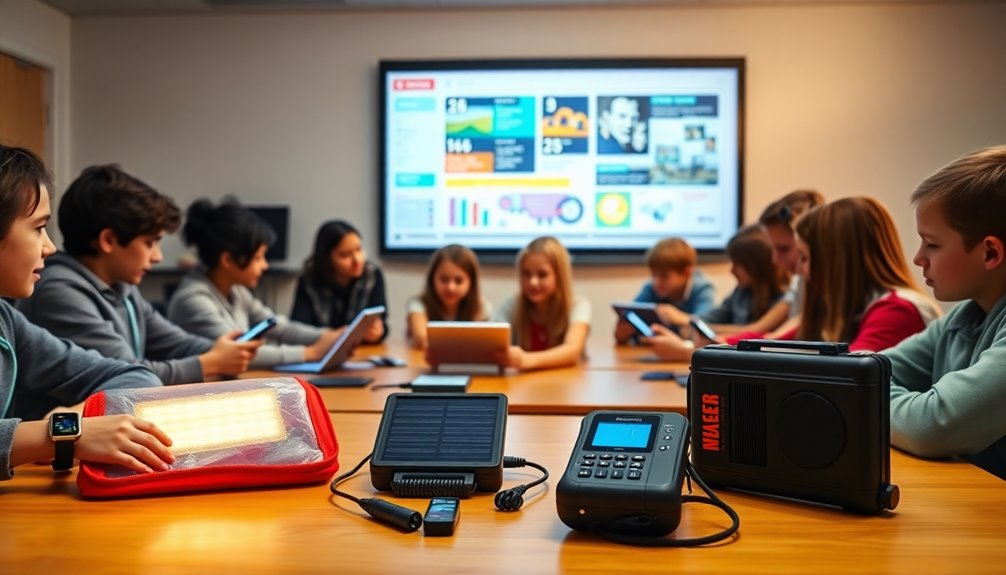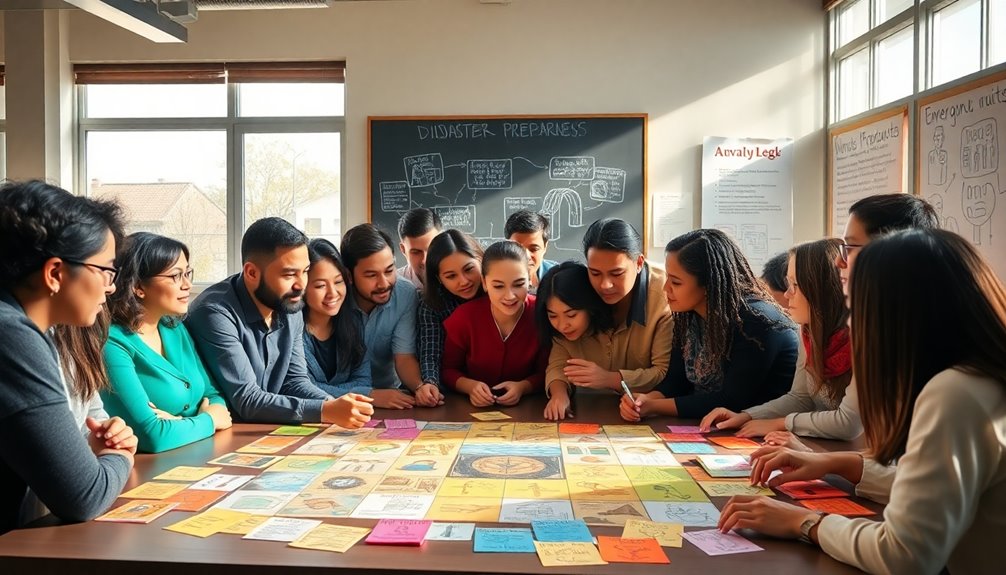A disaster preparedness quiz serves as a crucial assessment tool to gauge your readiness for emergencies. It helps identify gaps in emergency plans and disaster supply kits. Many people may feel emotionally prepared but lack practical measures, particularly in utilizing available resources. The quiz can reveal essential knowledge gaps, encouraging proactive steps toward improvement. Additionally, leveraging technology can enhance your preparedness through apps that assist in creating personalized plans and offer real-time updates. Exploring these aspects can greatly elevate your readiness level in disaster scenarios. More insights on enhancing preparedness can be explored further.
Key Takeaways
- Assess your current preparedness level by evaluating your emergency plans and disaster supply kits.
- Identify gaps in knowledge by taking a quiz that covers essential disaster preparedness topics and resources.
- Familiarize yourself with essential tech tools that can enhance your safety, such as emergency apps and communication devices.
- Participate in community workshops to learn about effective disaster response strategies and tech utilization.
- Use quizzes as a fun method to increase awareness and readiness for potential emergencies in your area.
Assessing Your Current Preparedness
Evaluating your current preparedness for disasters is an essential step in ensuring your safety and well-being. While many older adults express a sense of readiness, a significant number have not taken proactive measures, such as creating emergency plans or assembling disaster supply kits. To effectively safeguard yourself, it’s crucial to take inventory of your resources and identify any gaps in your preparation. Preparing for disaster scenarios involves not only having an emergency plan but also ensuring that you have the necessary supplies and support networks in place. By taking these proactive steps, you can greatly enhance your resilience and ensure that you are ready to face any challenges that may arise.
Awareness of available resources, particularly technological tools, remains low among various demographics, contributing to a disparity in preparedness levels. Emotional readiness often does not translate into practical preparedness, highlighting the need for thorough assessments.
Individuals should reflect on their knowledge of local hazards, evacuation routes, and communication strategies. This self-evaluation can identify gaps and motivate action, ultimately fostering a more resilient community capable of effectively responding to emergencies.
Leveraging Technology for Safety

In today's increasingly digital world, leveraging technology for safety during emergencies has become essential for effective disaster preparedness. The integration of various technological tools enhances situational awareness and facilitates timely communication, which can greatly mitigate the impact of disasters.
Key benefits of utilizing technology for safety include:
- Real-time updates: Access to live information regarding weather changes and emergency alerts.
- Emergency planning apps: Tools that guide users in creating personalized emergency plans and checklists.
- Community connectivity: Platforms that enable sharing resources and support within local networks during crises.
Must-Have Tech Tools

As the reliance on technology for safety becomes increasingly evident, identifying must-have tech tools for disaster preparedness is essential.
First and foremost, smartphones should be equipped with emergency contact information and relevant apps, including weather alerts and emergency planning tools.
Portable chargers and backup batteries are critical for ensuring devices remain operational during power outages.
Additionally, emergency radios provide important updates when other communication channels may fail.
Moreover, GPS technology can aid in navigation, helping individuals find safe routes amidst chaos.
Collectively, these tech tools enhance not only individual preparedness but also community resilience, fostering a proactive approach to disaster readiness.
Recovery Resources Post-Disaster

Recovery resources post-disaster play an essential role in helping individuals and communities rebuild and regain stability.
These resources are crucial for facilitating the recovery process, providing support, and ensuring that affected populations can access necessary services.
Effective recovery efforts can greatly reduce the long-term impacts of disasters, promoting resilience and preparedness for future events.
- Federal and State Assistance: Government programs offer financial aid, housing support, and mental health services.
- Nonprofit Organizations: Local and national NGOs provide food, shelter, and volunteer efforts to assist recovery.
- Community Support Networks: Grassroots initiatives foster connections, sharing resources, and emotional support among those affected.
Bridging Knowledge Gaps

Bridging knowledge gaps regarding technology's role in disaster preparedness is essential for empowering older adults and enhancing community resilience. Many older adults remain unaware of the technological resources available to assist during emergencies. Educational programs and community workshops can effectively address these gaps, fostering a more informed population ready to utilize technology for safety.
| Tech Tool | Purpose |
|---|---|
| Smartphones | Emergency contact storage |
| Weather apps | Alerts and forecasts |
| Portable chargers | Powering devices during outages |
| Emergency radios | Access to critical information |
| Backup batteries | Ensuring device functionality |
Frequently Asked Questions
What Are Common Types of Disasters I Should Prepare For?
Common types of disasters to prepare for include natural events such as hurricanes, earthquakes, floods, and wildfires, as well as human-made emergencies like industrial accidents, terrorism, and pandemics. Awareness and proactive planning are essential for effective preparedness.
How Can I Involve My Family in Preparedness Planning?
Involving family in preparedness planning can be achieved through collaborative discussions, establishing emergency roles, conducting drills, and utilizing technology for communication. Educating all members on resources guarantees a thorough and effective approach to disaster readiness.
What Supplies Should I Include in My Emergency Kit?
Like a sailor preparing for a storm, your emergency kit should include essentials such as water, non-perishable food, first aid supplies, flashlights, batteries, and a multi-tool—items that guarantee safety and resilience during unforeseen events.
How Often Should I Update My Emergency Plan?
Regularly updating your emergency plan is vital. Review it at least annually or whenever significant changes occur in your household, such as new members, relocations, or changes in health, ensuring preparedness remains relevant and effective.
What Is the Best Way to Stay Informed During a Disaster?
Staying informed during a disaster is best achieved through a combination of mobile apps, social media platforms, and emergency alerts, which provide real-time updates and critical information, enhancing personal safety and community connectivity.
Conclusion
In a world where storms loom and uncertainty reigns, the importance of disaster preparedness emerges as a beacon of hope. The fragile thread of safety can be woven stronger through awareness and technology, transforming intimidating challenges into manageable tasks. By illuminating the shadows of ignorance with knowledge, individuals can stand resilient against the tempest, equipped with essential tools and strategies. Ultimately, proactive engagement in preparedness efforts not only safeguards lives but also fosters a community united in strength and readiness.









